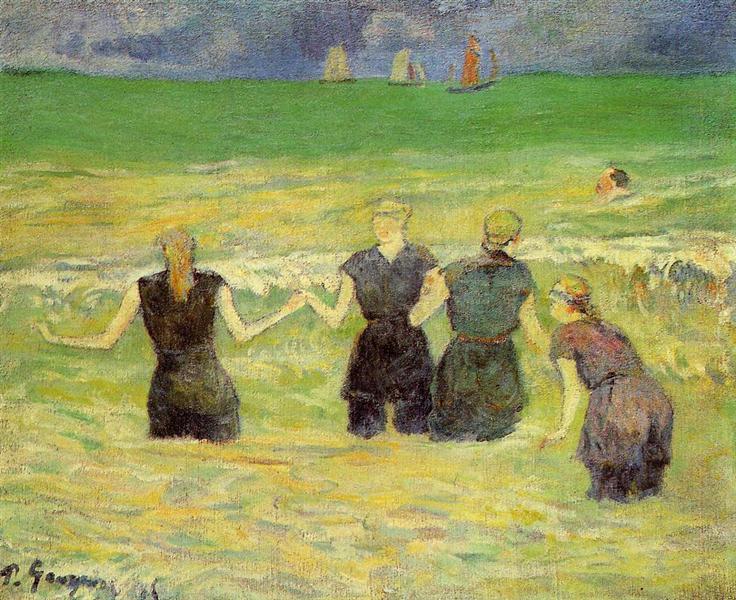Popis
Práce „Ženy koupání (Dieppe)“ od Paula Gauguina, malované v roce 1885, nabízí podmanivou vizi intimity a každodenního života v kontextu francouzského venkovského života. Tento olej na plátně odráží charakteristický styl Gauguina, který, ačkoli byl stále ve svých prvních krocích k hledání symboličtějšího a osobního umění, již začal experimentovat s kolorimetrií a složením, které by z něj proslavilo v pozdějších letech .
V tomto obraze pozorujeme skupinu žen, které jsou podle tradice času věnovány koupání v přirozeném kontextu. Scéna se nachází v Dieppe, pobřežním městě Normandie, což naznačuje letní prostředí, které zve odpočinek a socializaci. Postavy mají ve stylu, který se dotýká stylizovaného, sklouznutí na povrchu plátna, z nichž každá je oddaná na vlastní okamžik introspekce a relaxace. Pohyby žen jsou zachyceny téměř éterickou milostí, což naznačuje přímé spojení s přírodou a pocit svobody, který odráží Gauguinovu touhu vykreslit ženskou podstatu.
Paleta barev práce je další z jejích pozoruhodných charakteristik. Gauguin se rozhodl pro pulzující a nasycené tóny, které přinášejí malování téměř hmatatelné vitality. Modrá a zelená vegetace je propojena se světlejšími a nejpřípřemi tóny ženských kůží a vytváří kontrast, který nejen zdůrazňuje lidské postavy, ale také vytváří vizuální dialog, který podporuje scénu. Toto odvážné použití barvy je preambulem pro nejsmírnější paletu, kterou by Gauguin použil ve svých následných dílech, zejména během jeho doby na Tahiti.
Postavy, kromě jednoduše reprezentací každodenního života, ztělesňují rozmanitost nuancí v emocích a vyjádření. Prostřednictvím svého portrétu Gauguin nejen zachycuje podstatu každé ženy ve svém vlastním světě, ale také vyvolává problémy o ženské roli a svobodě ve společnosti své doby. Ženy, i když jsou fyzicky ve stejném prostoru, se zdají být ponořeny do jejich soukromých myšlenek, což naznačuje určitou introspekci a osobní prostor pro spojení, který přesahuje povrchnost koupání.
Na úrovni kompozice se Gauguinova práce spoléhá na rovnováhu mezi čísly a životním prostředím. Měkké linie, které rámují formy žen a likvidace krajiny, slouží k vytvoření vizuálního toku, který vede pohled diváka během obrazu. Toto použití kompozice ke sjednocení postav a krajiny je charakteristické pro impresionismus, pohyb, ke kterému Gauguin zpočátku patřil, než se pustil k symboličtějšímu a expresionistickému umění.
„Ženy koupání (Dieppe)“ představuje okamžik ve vývoji Gauguina, kde se stále drží určitých principů impresionismu, zatímco začal nastínit základy svého jedinečného uměleckého jazyka. Ačkoli tento obraz nedosáhne emocionální a symbolické složitosti jeho následných děl, jako jsou ty, které se provádějí v Polynésii, nabízí pohled na jeho cestu a jeho schopnost transformovat každodenní do nějaké jemnosti a hloubky. Tato práce se tedy neomezuje pouze na to, že je jednoduchá studie ženské postavy; Spíše zve diváka, aby uvažoval o klidu, intimitě a okamžiku spojení s povahou, kterou představuje, spektrum emocí, které je v srdci Gauguinova umění.
KUADROS ©, slavná barva na vaší zdi.
Ručně -vyráběné olejomalby s kvalitou profesionálních umělců a výraznou pečetí KUADROS ©.
Obrázky reprodukční služba se zárukou spokojenosti. Pokud nejste zcela spokojeni s replikou vašeho obrazu, vrátíme vaše peníze 100%.

